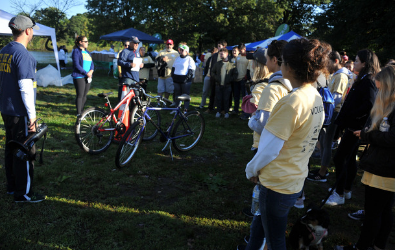Two weeks ago, I had the opportunity to volunteer for two fundraising walks in Boston–the Samaritans 20th Annual Run/Walk for Suicide Prevention and the American Cancer Society Making Strides Against Breast Cancer Walk. Walks, races, and anything else with the suffix a-thon attached are a major source of funding for nonprofits, but they also call for a lot of man power, especially from volunteers. How you communicate with volunteers before, during, and after the event are essential to the volunteers’ experience, as well as to your event’s success.
Before the event, make sure your volunteers are prepared for the day. Walks and races can last a long time, and require volunteers to be on their feet for several hours. Make sure they know what to wear and make suggestions based on your insider knowledge from past events. For example, the Making Strides Walk starts at 6 a.m. and takes place by the Charles River, so it is chilly in the morning, and our volunteer coordinator clearly communicated this in her emails to us before the walk. Tell volunteers if there will be food provided, or if there is anything specific you would like them to bring (or not bring) to the event. Let your volunteers know exactly when and where you would like them to check in upon arrival, where to park, and a site coordinator’s contact info in case of emergencies. All of this info may seem obvious, but your volunteers will appreciate being informed and it will avoid confusion during the main event.
During the event, communicating with your volunteers and providing clear and complete training and instructions is vital for their success, and yours. A site walk-through is a great way to give volunteers the lay of the land, especially since participants will likely ask volunteers questions about where everything is located. If volunteers are helping with registration or check in, remind them that they should ask participants if they would like to make an additional donation to the organization. For example, I was working the day-of registration for the Samaritans Run/Walk, and we asked every participant if they would like to make an additional donation–and more often than not, people did make a contribution. Encourage volunteers to share and tag photos from the event on social media. Samaritans shared a photo I took on their Instagram story, and I felt more engaged and excited to be volunteering for them.
This tip may also seem obvious, but say thank you! A thank you can go a long way in making volunteers feel that they had an impact. If the event was a fundraiser, tell volunteers how much you raised and how many people registered. Volunteers who were part of any on-site fundraising efforts will feel a sense of pride knowing the results. Be sure to thank them in person before they leave, and follow up with a thank you via email. In the post-event thank you email, tell your volunteers how to continue their involvement with your organization, if there are any specific volunteer opportunities coming up, and how to register for them. This will keep those volunteers involved and engaged while your organization is still top of mind. A thank you email is also an opportunity to get feedback. You can use SurveyMonkey to create a short questionnaire about the volunteer experience, which will help the event run more smoothly in the future.
I had a great time volunteering for these two nonprofits, in part because I felt engaged and informed from their communications. Go forth and master those volunteer communications, and good luck with your organization’s next big event!


